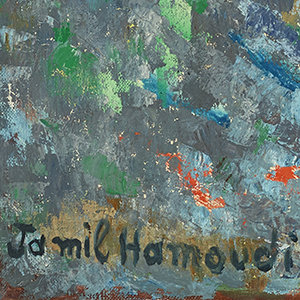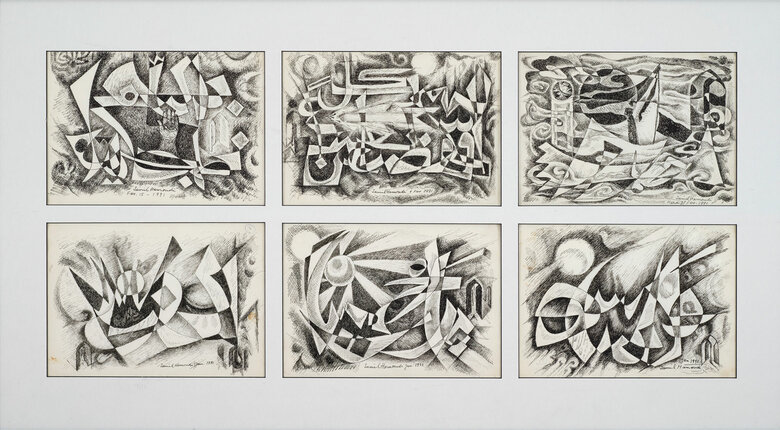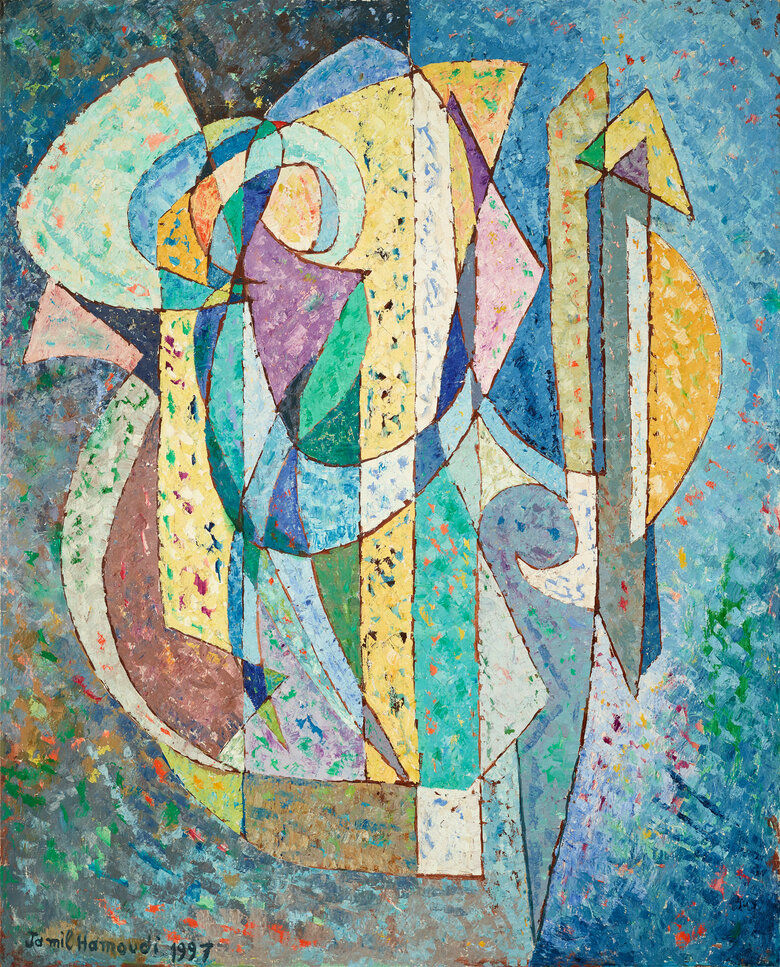Born in Baghdad in 1924, Jamil Hammoudi was initially a self-taught artist. Early on, he became involved in the cultural and artistic scene in Iraq. In 1941, some art amateurs and artists,...


JAMIL HAMMOUDI, Iraq (1924 - 2003)
Bio
Written by ARTHUR DEBSI
Born in Baghdad in 1924, Jamil Hammoudi was initially a self-taught artist. Early on, he became involved in the cultural and artistic scene in Iraq. In 1941, some art amateurs and artists, including Jewad Selim (1919-1961) and Hafidh Droubi (1914-1991), founded the Friends of the Arts Society (Jama’at Asdiqa al-Fann). When World War II broke out, these artists came back from Europe, where they had been studying for a couple of years. They decided to promote artistic activities, which were barely developed in the country. In 1942, Jamil Hammoudi joined the members of the group, and two years later, he started his education at the Institute of Fine Arts in Baghdad, studying painting, and sculpture.
In 1945, Jamil Hammoudi became editor in chief and director of publication for Modern Thought magazine, Al-Fikr al-Hadith. In the forty-decade of the 20th century, this magazine marked a pivotal moment in modern art and the intellectual field in Iraq. Being the first magazine of the country dedicated to art and culture, it included artistic studies, theories, and also presented itself as the reference for art criticism in Iraq1. In 1946, Hammoudi became Secretary-General of the Friends of the Arts Society (Jama’at Asdiqa al-Fann), and was granted a governmental scholarship to pursue his studies in France. He enrolled at the École Supérieure des Beaux-Arts in Paris in 1947, and also attended courses at prestigious institutions, such as the Académie Julian, the École du Louvre, and the Faculty of Fine Arts at the Sorbonne University. In the French capital city, Jamil Hammoudi was very active in the cultural scene, as he exhibited his artwork in several galleries. He even became member of the Salon des Réalités Nouvelles in 1949. It aims to promote abstract art, even until today. In parallel to his painting career, Hammoudi published a few poems in French under the title Dreams from the East, and founded the quarterly French magazine Ishtar: Orient-Occident in 1958.
In 1962, Jamil Hammoudi relocated to Baghdad, but did not break off all ties with France. He continued to exhibit in Paris several times. During the 1970s, the artist vividly exhibited, and he took the position of supervisor of the department of art affairs at the Directorate General of Arts of the Ministry of Information in 1973. Jamil Hammoudi retired in 1989, and founded the hall called ‘Inana’ in Baghdad – an art space, where he could encourage the work on letters in the art practice in Iraq.
At the very beginning of his artistic journey, Jamil Hammoudi was a Surrealist painter. Eventually, he detached himself from this avant-garde movement, while he was living in Paris. He felt that Surrealism was somehow contrary to his principles. More generally, he actually thought that his life in France could lead him to lose his cultural affiliation2, as he stated: “Fear from being lost in a culture, which did not relate to my intellectual and national experience, produced within me a revolt against the materialistic values which were the outcome of a civilization based on tools, machinery, and cheap materials”3. Therefore, he progressively reconnected to his history and culture. He did so by conducting thorough research on the civilizations from Mesopotamia, such as the Assyrian and Babylonian. On the other hand, he carefully studied the abstract origins in ancient Iraqi art. Yet, the Arabic letter remained at the core of his research and experimentation throughout his career. He stated: “The very moment at which the idea came to me to seek inspiration in the Arabic letters in art was a kind of supplication and prayer for a soul intimidated by the emptiness which dominated European life”4.
Most of the literature on Hammoudi’s artworks agree that he, alongside Iraqi painter Madiha Omar (1908-2005), was the very first Arab artist to integrate Arabic letters in their work5, as of the end of the 1940s6.
It may be recalled that the letter was a significant source of inspiration for modern Arab artists, who developed many theories in the beginning of the 1970s. Among these theories was the One Dimension (Al-Bu’d al-Wahid), initiated by Shaker Hassan al Said (1925-2004). It attracted multiple Iraqi artists, who exhibited on January 28th 1971 under this name. These artists saw the use of the Arabic letters in artworks as a way to create a common aesthetic, which was both modern and Arab. Furthermore, this approach gave rise to a term called hurufiyah, which “deal[t] with the Arabic language, letters or text, as a visual element for composing”7. Although the artistic program of One Dimension aimed to promote the cultural heritage of the Arab-Islamic civilization, it was slightly different from the modern Arab art movements in the 1950s. The latter was regarded as ‘local’, whereas the theory of One Dimension sought a more regional plastic language, comprehensible by all the Arab populations. This also happened in a specific historical context, when the sense of community had grown among the people of the Arab world, especially after the Six-Day War in 19678.
In the 1970s, Jamil Hammoudi was a key member of the group of One Dimension, imposing himself as a great figure of hurufiyah. This can be seen in the work entitled Fi el-Nour (1997) as part of the Dalloul Art Foundation’s collection. Filling the entire space of the canvas, the artist produced a two-dimensional drawing, synthetizing the forms of the elements that he arranged like a construction, reminding of the geometric abstraction of Cubism. By contemplating this painting, the viewer could only recognize the letters ‘alif’, and ‘ain’, since the reading remains difficult. Hammoudi did not properly write a word, but stylized the Arabic script by superimposing the letters and playing with the curved lines (al-muqawwar) and straight lines (al-mustaqim). He actually did not aim to use the letters to communicate, but to convey the dynamic and the emotions, which emerge from their shapes. Jamil Hammoudi considered the use of the letters to be spiritual. They enabled him to give free rein to his creativity. This spiritual dimension could be found in the application of bright colors and the effect of transparency rendered by a variation of tones. This process makes the composition particularly luminous, as its title means ‘in the light’ in Arabic. It is then possible to relate this work on luminosity to the divine presence, which is somehow hidden behind the letters.
Apart from being an accomplished artist, Jamil Hammoudi was also an important art critic, whose thoughts were applied in his experimental works. These experimentations highly contributed to the elaboration of modern art in Iraq, and more generally in the Arab countries. Choosing the Arabic letter as the fundamental element of his practice, helped Hammoudi to build a connection with his cultural identity, and to legitimize the positions of Arab artists – especially Syrian, and Iraqi artists – in the international modern art movements, namely abstraction.
Jamil Hammoudi passed away in 2003.
Notes
1 Abdul Saheb Mohsen Rashid al-Fatlawai, Shrook, and Mohamed Juwaid Husseina. “The Intellectual Dimensions in Contemporary Painting and Their Implications for Productions (Students of Art Education).” PalArch's Journal of Archeology of Egypt/Egyptology, no. 18 (March 2021). [P.4781]
2 Shabout, Nada M. Modern Arab Art: Formation of Arab Aesthetics. Gainesville: University Press of Florida, 2015. [P.73]
3 Jamil Hammoudi quoted in Salim, Nizar. Iraq Contemporary Art: Vol. I, Painting. Lausanne: Sartec, 1977. [P.206]
4 Ibid.
5 Shabout, Nada M. Modern Arab Art: Formation of Arab Aesthetics. Gainesville: University Press of Florida, 2015. [P.71]
6 Naef, Silvia. A La Recherche D'une modernité Arabe L'évolution Des Arts Plastiques En Egypte, Au Liban Et En Irak. Genève, Switzerland: Slatkine Reprints, 1996. [P.317]
7 Charbel Dagher, Al-Hurufiyah al-Arabiyah: Fann wa Hawiyah (Arab Letterism: Art and Identity). Beirut: Sharikat al-Matbu’at Lil Tawzi’ wa al-Nashir, 1990 [P.11]. Quote in Shabout, Nada M. Modern Arab Art: Formation of Arab Aesthetics. Gainesville: University Press of Florida, 2015. [P.75]
8 The Six-Day War marked the defeat of the coalition of Arab countries (Jordan, Egypt, Syria) against Israel.
Sources
Eigner, Saeb. Art of the Middle East: Modern and Contemporary Art of the Arab World and Iran. London: Merrell, 2010.
Faraj, Maysaloun. Strokes of Genius: Contemporary Iraqi Art. London: Saqi Books, 2001.
Jabrā Jabrā Ibrāhīm. The Grass Roots of Iraqi Art. St. Helier, Jersey, C.I.: Wasit Graphic and Publishing Limited, 1983.
Lenssen, Anneka, Sarah A. Rogers, and Nada M. Shabout. Modern Art in the Arab World: Primary Documents. New York: The Museum of Modern Art, 2018.
Naef, Silvia. A La Recherche D'une modernité Arabe L'évolution Des Arts Plastiques En Egypte, Au Liban Et En Irak. Genève, Switzerland: Slatkine Reprints, 1996.
Naji, Ahmed. Under the Palm Trees: Modern Iraqi Art with Mohamed Makiya and Jewad Selim. New York, USA: Rizzoli International Publications Inc., 2019.
Pocock, Charles. Art in Iraq Today. Milano: Skira, 2011.
Pocock, Charles, and Nada Shabout. Modern Iraqi Art: a Collection. Dubai: Meem Art, 2013.
Salim, Nizar. Iraq Contemporary Art: Vol. I, Painting. Lausanne: Sartec, 1977.
Schroth, Mary Angela. Longing for Eternity, On century of Modern and Contemporary Iraqi Art, From the Hussain Ali Harba Family Collection. Milan, Italy: Skira, 2013.
Shabout, Nada M. Modern Arab Art: Formation of Arab Aesthetics. Gainesville: University Press of Florida, 2015.
العرب Al Arab. “جميل حمودي رائد الحروفية المنسي قبل أوانه: فاروق يوسف.” صحيفة العرب, 2017. https://alarab.co.uk/%D8%AC%D9%85%D9%8A%D9%84-%D8%AD%D9%85%D9%88%D8%AF%D9%8A-%D8%B1%D8%A7%D8%A6%D8%AF-%D8%A7%D9%84%D8%AD%D8%B1%D9%88%D9%81%D9%8A%D8%A9-%D8%A7%D9%84%D9%85%D9%86%D8%B3%D9%8A-%D9%82%D8%A8%D9%84-%D8%A3%D9%88%D8%A7%D9%86%D9%87.
CV
Selected Solo Exhibitions
1998
Sharjah Art Museum, Sharjah, United Arab Emirates
Al-Riwaq Gallery, Baghdad, Iraq
1997
Athar Gallery, Baghdad, Iraq
1988
Sharjah, United Arab Emirates
Aba’ad Galley, Baghdad, Iraq
1986
Musée National des Arts d’Afrique et d’Océanie, Paris, France
1965
Al-Wasiti Hall, Baghdad, Iraq
Selected Group Exhibitions
2024
Arab Presences: Modern Art And Decolonisation: Paris 1908-1988, Musée d'Art Moderne de Paris, Paris, France
2023
Partisans of the Nude: An Arab Art Genre in an Era of Contest, 1920-1960, Wallach Art Gallery, Columbia University, New York, USA
2021
When Images Speak, Etihad Museum, Dubai, United Arab Emirates
2016
Hurufiyya: Art & Identity, Bibliotheca Alexandrina, Alexandria, Egypt
2014
Tariqah, Barjeel Art Foundation, Sharjah, United Arab Emirates
1976
L’Art Irakien Contemporain, Musée d’Art Moderne de la Ville de Paris, Paris, France
1973
The 15th
exhibition of the Visual Artists Association, Hall of Visual Artists Association, Baghdad, Iraq
The 2nd
exhibition of the One Dimension Group, Baghdad, Iraq
Honors and Awards
2001
Medal of Honor, Paris, France
1987
Medal of Arts and Literature, Paris, France
Affiliations and Memberships
1971
One Dimension Group (Al-Bu’d al-Wahid)
1942
Friends of Art Association (Jama’at Asdiqa al-Fann)
Collections
Dubai Art Collection, Dubai, United Arab Emirates
Ibrahimi collection, Amman, Jordan
Sharjah Art Museum, Sharjah, United Arab Emirates
The Barjeel Art Foundation, Sharjah, United Arab Emirates
The Jordan National Gallery of Fine Arts, Amman, Jordan
The Ramzi and Saeda Dalloul Art Foundation, Beirut, Lebanon
Press
{يعتبر من رواد الحروفية_رحيل الفنان الحروفي العراقي جميل حمودي.pdf
جريدة الغد.pdf
جميل حمودي يستوحي الحياة من جمالية الحرف العربي - البيان.pdf
جميل حمودي رسام ونحات » صحيفة فنون الخليج.pdf
صحيفة التآخي - جميل حمودي .. ذاكرة الثقافة العراقية.pdf
معرض للفنان العراقي الراحل جميل حمودي وابنته عشتار.pdf
Barjeel Art Foundation Hosts Tariqah Exhibition - Magazine Islamic Arts Magazine.pdf
جميل حمودي.. الريادة في تشكيل الخط العربي - ملاحق جريدة المدى اليومية.pdf
Jamil Hamoudi _ Barjeel Art Foundation.pdf
Jamil Hamoudi _ Artscoops.pdf
Jamil Hammoudi_press release_by Farouk Youssif_AlArab.pdf
JAMIL HAMMOUDI Artwork
Become a Member
Join us in our endless discovery of modern and contemporary Arab art
Become a Member
Get updates from DAF
Follow Artists
Save your favourite Artworks
Share your perspectives on Artworks
Be part of our community
It's Free!
We value your privacy
TermsCookiesPrivacy Policies
Become a Member
Get updates from DAF
Follow Artists
Save your favourite Artworks
Share your perspectives on Artworks
Be part of our community
It's Free!
We value your privacy
TermsCookiesPrivacy Policies
Become a Member
Get updates from DAF
Follow Artists
Save your favourite Artworks
Share your perspectives on Artworks
Be part of our community
It's Free!
We value your privacy
TermsCookiesPrivacy Policies
Welcome to the Dalloul Art Foundation
Thank you for joining our community
If you have entered your email to become a member of the Dalloul Art Foundation, please click the button below to confirm your email and agree to our Terms, Cookie & Privacy policies.
We value your privacy, see how
Become a Member
Get updates from DAF
Follow Artists
Save your favourite Artworks
Share your perspectives on Artworks
Be part of our community
It's Free!
We value your privacy
TermsCookiesPrivacy Policies






